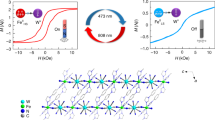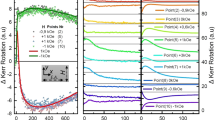Abstract
The light-induced phase transition between the low-spin (LS) and high-spin (HS) states of some transition-metal ions has been extensively studied in the fields of chemistry and materials science. In a crystalline extended system, magnetically ordering the HS sites of such transition-metal ions by irradiation should lead to spontaneous magnetization. Previous examples of light-induced ordering have typically occurred by means of an intermetallic charge transfer mechanism, inducing a change of valence of the metal centres. Here, we describe the long-range magnetic ordering of the extended FeII(HS) sites in a metal–organic framework caused instead by a light-induced excited spin-state trapping effect. The Fe–Nb-based material behaves as a spin-crossover magnet, in which a strong superexchange interaction (magnetic coupling through non-magnetic elements) between photo-produced FeII(HS) and neighbouring NbIV atoms operates through CN bridges. The magnetic phase transition is observed at 20 K with a coercive field of 240 Oe.
This is a preview of subscription content, access via your institution
Access options
Subscribe to this journal
Receive 12 print issues and online access
$259.00 per year
only $21.58 per issue
Buy this article
- Purchase on Springer Link
- Instant access to full article PDF
Prices may be subject to local taxes which are calculated during checkout




Similar content being viewed by others
References
Gütlich, P. & Goodwin, H. A. (eds.) Spin crossover in transition metal compounds I, II, III. Top. Curr. Chem. 233–235 (2004).
König, E. Structural changes accompanying continuous and discontinuous spin-state transitions. Prog. Inorg. Chem. 35, 527–622 (1987).
Cambi, L. & Szego, L. Über die magnetische Susceptibilität der komplexen Verbindungen. Ber. Dtsch Ges. 64, 2591–2598 (1931).
Baker, W. A. & Bobonich, H. M. Magnetic properties of some high-spin complex of iron(II). Inorg. Chem. 3, 1184–1188 (1964).
Kahn, O. & Martinez, C. J. Spin-transition polymers: from molecular materials toward memory devices. Science 279, 44–48 (1998).
Real, J. A. et al. Spin crossover in a catenane supramolecular system. Science 268, 265–267 (1995).
Létard, J. F. et al. Wide thermal hysteresis for the mononuclear spin-crossover compound cis-bis(thiocyanato)bis[N-(2′-pyridylmethylene)-4-(phenylethynyl)anilino]iron(II). J. Am. Chem. Soc. 119, 10861–10862 (1997).
Boukheddaden, K., Shteto, I., Hoo, B. & Varret, F. Dynamical model for spin-crossover solids. I. Relaxation effects in the mean-field approach. Phys. Rev. B 62, 14796–14805 (2000).
Bousseksou, A., Molnár, G., Demont, P. & Menegotto, J. Observation of a thermal hysteresis loop in the dielectric constant of spin crossover complexes: towards molecular memory devices. J. Mater. Chem. 13, 2069–2071 (2003).
Niel, V. et al. Crystalline-state reaction with allosteric effect in spin-crossover, interpenetrated networks with magnetic and optical bistability. Angew. Chem. Int. Ed. 42, 3760–3763 (2003).
Halder, G. J., Kepert, C. J., Moubaraki, B., Murray, K. S. & Cashion, J. D. Guest-dependent spin crossover in a nanoporous molecular framework material. Science 298, 1762–1765 (2002).
Gaspar, A. B., Seredyuk, M. & Gütlich, P. Spin crossover in metallomesogens. Coord. Chem. Rev. 253, 2399–2413 (2009).
Arai, M., Kosaka, W., Matsuda, T. & Ohkoshi, S. Observation of an Fe(II) spin-crossover in an iron octacyanoniobate-based magnet. Angew. Chem. Int. Ed. 47, 6885–6887 (2008).
Decurtins, S., Gütlich, P., Köhler, C. P., Spiering, H. & Hauser, A. Light-induced excited spin state trapping in a transition-metal complex: the hexa-1-propyltetrazole–iron(II) tetrafluoroborate spin-crossover system. Chem. Phys. Lett. 105, 1–4 (1984).
Gütlich, P., Hauser, A. & Spiering, H. Thermal and optical switching of iron(II) complexes. Angew. Chem. Int. Ed. Engl. 33, 2024–2054 (1994).
Nasu, K. Relaxations of Excited States and Photo-Induced Structural Phase Transitions (Springer, 1997).
Létard J. F. et al. Structural, magnetic, and photomagnetic studies of a mononuclear iron(II) derivative exhibiting an exceptionally abrupt spin transition. Light-induced thermal hysteresis phenomenon. Inorg. Chem. 37, 4432–4441 (1998).
Ogawa, Y. et al. Dynamical aspects of the photoinduced phase transition in spin-crossover complexes. Phys. Rev. Lett. 84, 3181–3184 (2000).
Renz, F. et al. Strong field iron (II) complex converted by light into a long-lived high-spin state. Angew. Chem. Int. Ed. 39, 3699–3700 (2000).
Ould-Moussa, N. et al. Wavelength selective light-induced magnetic effects in the binuclear spin crossover compound {[Fe(bt)(NCS)2]2(bpym)}. Phys. Rev. B 75, 054101 (2007).
Ould-Moussa, N. et al. Selective photoswitching of the binuclear spin crossover compound {[Fe(bt)(NCS)2]2(bpm)} into two distinct macroscopic phases. Phys. Rev. Lett. 94, 107205 (2005).
Breuning, E. et al. Spin crossover in a supramolecular Fe4II [2×2] grid triggered by temperature, pressure, and light. Angew. Chem. Int. Ed. 39, 2504–2507 (2000).
Nishihara, T., Nihei, M., Oshio, H. & Tanaka, K. The light-induced spin transition of tetranuclear spin crossover complex [Fe4(CN)4(bpy)4(tpa)2](PF6)4 . J. Phys.: Confer. Ser. 148, 012033 (2009).
Teale, R. W. & Temple, D. W. Photomagnetic anneal, a new magneto-optic effect, in Si-doped yittrium iron garnet. Phys. Rev. Lett. 19, 904–905 (1967).
Enz, U. & Van der Heide, H. Two new manifestations of the photomagnetic effect. Solid State Commun. 6, 347–349 (1968).
Sato, O., Iyoda, T., Fujishima, A. & Hashimoto, K. Photoinduced magnetization of a cobalt-iron cyanide. Science 272, 704–705 (1996).
Shimamoto, N., Ohkoshi, S., Sato, O. & Hashimoto, K. Control of charge-transfer-induced spin transition temperature on cobalt–iron prussian blue analogues. Inorg. Chem. 41, 678–684 (2002).
Ohkoshi, S. et al. Photoinduced magnetization in copper octacyanomolybdate. J. Am. Chem. Soc. 128, 270–277 (2006).
Tokoro, H. et al. Visible-light-induced reversible photomagnetism in rubidium manganese hexacyanoferrate. Chem. Mater. 20, 423–428 (2008).
Ohkoshi, S., Einaga, Y., Fujishima, A. & Hashimoto, K. Magnetic properties and optical control of electrochemically prepared iron–chromium polycyanides. J. Electroanal. Chem. 473, 245–249 (1999).
Arimoto, Y., Ohkoshi, S., Zhong, Z. J., Seino, H., Mizobe, Y. & Hashimoto K. Photoinduced magnetization in a two-dimensional cobalt octacyanotungstate. J. Am. Chem. Soc. 125, 9240–9241 (2003).
Ohkoshi, S., Ikeda, S., Hozumi, T., Kashiwagi, T. & Hashimoto, K. Photoinduced magnetization with a high Curie temperature and a large coercive field in a cyano-bridged cobalt–tungstate bimetallic assembly. J. Am. Chem. Soc. 128, 5320–5321 (2006).
Ohkoshi, S. & Hashimoto, K. Design of a novel magnet exhibiting photoinduced magnetic pole inversion based on molecular field theory. J. Am. Chem. Soc. 121, 10591–10597 (1999).
Bozdag, K. D. et al. Optical control of magnetization in a room-temperature magnet: V–Cr Prussian blue analog. Phys. Rev. B 82, 094449 (2010).
Yoo, J.-W., Edelstein, R. S., Lincoln, D. M., Raju, N. P. & Epstein, A. J. Photoinduced magnetism and random magnetic anisotropy in organic-based magnetic semiconductor V(TCNE)x films, for x~2. Phys. Rev. Lett. 99, 157205 (2007).
Bénard, S., Rivière, E., Yu, P., Nakatani, K. & Delouis, J. F. A photochromic molecule-based magnet. Chem. Mater. 13, 159–162 (2001).
Kida, N. et al. Control of charge transfer phase transition and ferromagnetism by photoisomerization of spiropyran for an organic–inorganic hybrid system, (SP)[FeIIFeIII(dto)3] (SP = spiropyran, dto = C2O2S2). J. Am. Chem. Soc. 131, 212–220 (2009).
Morimoto, M., Miyasaka, H., Yamashita, M. & Irie, M. Coordination assemblies of [Mn4] single-molecule magnets linked by photochromic ligands: photochemical control of the magnetic properties. J. Am. Chem. Soc. 131, 9823–9835 (2009).
Venkataramani, S., Jana, U., Dommaschk, M., Sönnichsen, F. D., Tuczek, F. & Herges, R. Magnetic bistability of molecules in homogeneous solution at room temperature. Science 331, 445–448 (2010).
Koshihara, S. et al. Ferromagnetic order induced by photogenerated carriers in magnetic III–V semiconductor heterostructures of (In,Mn)As/GaSb. Phys. Rev. Lett. 78, 4617–4620 (1997).
Sieklucka, B. et al. Towards high Tc octacyanometalate-based networks. CrystEngComm. 11, 2032–2039 (2009).
Pinkowicz, D. et al. Magnetic spongelike behavior of 3D ferromagnetic {[MnII(imH)]2[NbIV(CN)8]}n with Tc=62 K. Inorg. Chem. 47, 9745–9747 (2008).
Kosaka, W., Imoto, K., Tsunobuchi, Y. & Ohkoshi S. Vanadium octacyanoniobate-based magnet with a Curie temperature of 138 K. Inorg. Chem. 48, 4604–4606 (2009).
Herrera, J. M. et al. Three-dimensional bimetallic octacyanidometalates [MIV{(μ-CN)4MnII(H2O)2}2·4H2O]n (M = Nb, Mo, W): synthesis, single-crystal X-ray diffraction and magnetism. C. R. Chimie 11, 1192–1199 (2008).
Kahn, O. Molecular Magnetism (VCH, 1993).
Brown, D. B. Mixed Valence Compounds (NATO ASI, 1980).
Prassides, K. Mixed Valency Systems: Applications in Chemistry, Physics and Biology (NATO ASI, 1991).
Robin M. B. & Day P. Mixed valence chemistry—a survey and classification. Adv. Inorg. Chem. Radiochem. 10, 247–422 (1967).
Hennig, H., Rehorek, A., Rehorek, D. & Thomas, Ph. Photocatalytic systems. LVIII. Electron transfer in copper(I)/octacyauomolybdate(V) ion pairs generated by IT excitation. Inorg. Chim. Acta 77, L11–L12 (1983).
Kosaka, W., Nomura, K., Hashimoto, K. & Ohkoshi, S. Observation of an Fe(II) spin-crossover in a cesium iron hexacyanochromate. J. Am. Chem. Soc. 127, 8590–8591 (2005).
Cheetham, A. K., Férey, G. & Loiseau, T. Open-framework inorganic materials. Angew. Chem. Int. Ed. 38, 3269–3292 (1999).
Eddaoudi, M. et al. Modular chemistry: secondary building units as a basis for the design of highly porous and robust metal–organic carboxylate frameworks. Acc. Chem. Res. 34, 319–330 (2001).
Kitagawa, S., Kitaura, R. & Noro, S. Functional porous coordination polymers. Angew. Chem. Int. Ed. 43, 2334–2375 (2004).
Ferlay, S., Mallah, T., Ouahès, R., Veillet, P. & Verdaguer, M. A room-temperature organometallic magnet based on Prussian blue. Nature 378, 701–703 (1995).
Verdaguer, M. et al. Room-temperature molecule-based magnets. Phil. Trans. R. Soc. Lond. A 357, 2959–2976 (1999).
Holmes, S. M. & Girolami, G. S. Sol–gel synthesis of KVII[CrIII(CN)6]·2H2O: a crystalline molecule-based magnet with a magnetic ordering temperature above 100 °C. J. Am. Chem. Soc. 121, 5593–5594 (1999).
Hatlevik, Ø., Buschmann, W. E., Zhang, J., Manson, J. L. & Miller, J. S. Enhancement of the magnetic ordering temperature and air stability of a mixed valent vanadium hexacyanochromate(III) magnet to 99 °C (372 K). Adv. Mater. 11, 914–918 (1999).
Acknowledgements
The authors acknowledge support from the Core Research for Evolutional Science and Technology (CREST) project of JST, a Grant-in-Aid for Young Scientists (S) from JSPS, the Global COE Program, ‘Chemistry Innovation through Cooperation of Science and Engineering’ from MEXT Japan, the Photon Frontier Network Program from MEXT, the Izumi Science and Technology Foundation and the Asahi Glass Foundation. The authors are grateful to Kosuke Nakagawa, Koji Nakabayashi and Tomohiro Nuida for their assistance with measurements, and to Wataru Kosaka for help with the synthesis. Acknowledgements are also given to the Cryogenic Research Center, The University of Tokyo and the Center for Nano Lithography & Analysis, The University of Tokyo, supported by MEXT Japan.
Author information
Authors and Affiliations
Contributions
S.O. designed and coordinated this study, contributed to all measurements and calculations, and wrote the paper. K.I. carried out the synthesis, photo-irradiation measurements and Mössbauer spectroscopy. Y.T. conducted Rietveld analysis. S.T. performed the synthesis and elemental analysis. H.T. carried out photo-irradiation measurements and molecular-field calculations. All authors commented on the manuscript.
Corresponding author
Ethics declarations
Competing interests
The authors declare no competing financial interests.
Supplementary information
Supplementary information
Supplementary information (PDF 1571 kb)
Supplementary information
Crystallographic data for the Mn-Nb-based metal-organic framework (CIF 24 kb)
Supplementary information
Crystallographic data for the Fe-Nb-based metal-organic framework (CIF 13 kb)
Rights and permissions
About this article
Cite this article
Ohkoshi, Si., Imoto, K., Tsunobuchi, Y. et al. Light-induced spin-crossover magnet. Nature Chem 3, 564–569 (2011). https://doi.org/10.1038/nchem.1067
Received:
Accepted:
Published:
Issue Date:
DOI: https://doi.org/10.1038/nchem.1067
This article is cited by
-
Ultrafast and persistent photoinduced phase transition at room temperature monitored by streaming powder diffraction
Nature Communications (2024)
-
Giant adiabatic temperature change and its direct measurement of a barocaloric effect in a charge-transfer solid
Nature Communications (2023)
-
Synthesis, characterization, in vitro antimicrobial activity, DNA binding assay, antioxidant and anti-inflammatory efficacy of trinuclear heterobimetallic complexes of Ni(II) derived by the reaction of [Ni(C13H12N2O)2]Cl2 with dialkyl/diaryl organometallic dichlorides
Research on Chemical Intermediates (2023)
-
Thickness-dependent spin bistable transitions in single-crystalline molecular 2D material
npj 2D Materials and Applications (2022)
-
Fluorescence emission modulation in cyanido-bridged Fe(II) spin crossover coordination polymers
Science China Chemistry (2022)



